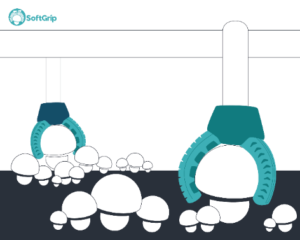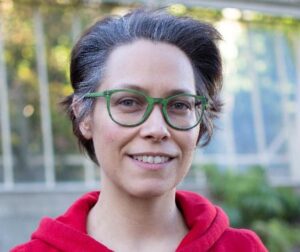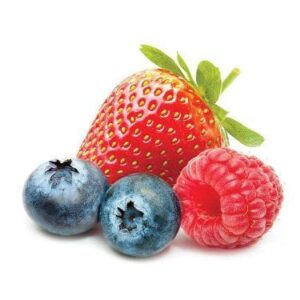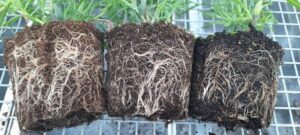AUTOMATED MONITORING OF INSECT PESTS
|
GRIPPING MUSHROOM RESEARCH
The gripper will ‘learn’ how to harvest mushrooms by imitating the harvesting process performed by human harvesters. Novel, ‘intelligent’ materials will be developed for the surfaces of the gripper that are food-safe, self-repairable and recyclable so they are more environmentally sustainable. Engineers and scientists from five countries are involved and Teagasc’s role is to ensure that all elements of SoftGrip are compatible with current mushroom growing systems. Over 80% of Irish mushrooms are exported to the fresh market in Britain where the demand is for high quality, blemish-free mushrooms. Robot grippers which have been developed to date tend to leave pressure marks on the mushroom which is unacceptable in the demanding British market. In due course, the SoftGrip prototype will be demonstrated on Teagasc’s mushroom research unit. For more information contact Dr. Helen Grogan – helen.grogan@teagasc.ie ✽ |
LETTUCE PRODUCTIONSupporting decision making on agricultural input reduction Food loss and waste are associated with greenhouse gas emissions and negative impacts to natural resources. The promotion of responsible food production which limits agricultural inputs, harnesses ecosystem services and reduces crop losses, aligns with the United Nations’ Sustainable Development Goals (SDGs), particularly goal 12 “Responsible Consumption and Production, as well as circular economy principles and the EU Green Deal objectives to address the challenges of sustainable food systems. This workshop is part of an STFC (Science and Technology Facilities Council) Food Network+ funded project to develop a data-based decision support model for growers seeking strategies to reduce agricultural inputs while minimising food loss. Field-grown head lettuce is being used as the exemplar crop in the development of this proof-of-concept tool. Participants (experts) will be given training in a structured expert judgement protocol and then asked to give private, individual estimates of food loss under a variety of scenarios. The estimates from each of the experts will be anonymised and presented back to the group for a facilitated discussion. Estimates may be revised through a second round of private, individual estimates. Estimates will then be aggregated and averaged to provide data for the decision support model. The model will become available as a web-based tool. The project team includes Dr. Lael Walsh at Teagasc, Dr. Martine Barons and Dr. Linda Nichols at the University of Warwick and Edward Salakpi at the University of Sussex For more information contact Dr. Lael Walsh at Teagasc – Lael.walsh@teagasc.ie or visit www.teagasc.ie/events. ✽ |
THE INTERNATIONAL YEAR OF FRUIT AND VEGETABLES 2021
A Guide to Vegetable Growing, Stephen Alexander – bit.ly/VegGrowingGuide Greenhouse Salad Crops – A Guide for Home Gardeners, Leo Finn, and Michael Gaffney – bit.ly/GreenhouseSaladsit. ✽ |
NEW STRAWBERRY VARIETY TRIAL BEGINS ON SEVERAL SOFT FRUIT FARMSA new strawberry variety trial has begun on several soft fruit farms across Ireland. The trial is run in association with the Italian soft fruit plant propagators Mazzoni and Salvi-Vivai (also known as CIV). The trial will grow a number of ‘June bearing’ varieties in a range of protective structures including glasshouses, walk-in tunnels, and Spanish tunnels. The main aim is to see how the different strawberry varieties perform in these structures and in different parts of the country. All of the varieties will be grown in either peat or coco peat (coir) substrates. With the help of Teagasc, the growers will record the fruit weights and the fruit quality from the individual trial. The trials will include the growth of both early and mid-season varieties; ‘Joly’, ‘Sibilla’, ‘Lycia’ ‘Annely’ and ‘CIV 725’. The industry is always looking for new strawberry varieties that can complement the existing ones being grown and could potentially fill the existing gaps in production throughout the long season. Jim Kearns of Kearns Soft Fruit Farm near Enniscorthy, in Co. Wexford commented, “I am delighted about taking part in the trial as we are always on the lookout for new strawberry varieties to extend our fruit season”. ✽ |
SOFT FRUIT PRODUCTION FACTSHEETS TO SUPPORT NEW ENTRANTS
If you would like more information please feel free to contact our soft fruit adviser Dr Eamonn Kehoe – eamonn.kehoe@teagasc.ie. ✽ |
KILDALTON COLLEGE EMBRACES BOTANIC GARDEN STUDENTS FOR ONLINE MODULESLast year saw unprecedented changes in education, in the way classes are delivered, how lecturers and students interact, and courses assessed. As is frequently the case, challenges can bring opportunities to do things differently. This has been the case for students’ studying the Waterford Institute of Technology Bachelor of Science in Horticulture in the Botanic Gardens Dublin Campus. The move to the virtual classroom for delivery of lectures has created an opportunity for students to study modules delivered by Kildalton College lecturers, as part of their degree which were not available at the Botanic Gardens. This has created an opportunity for students from both colleges to meet, interact and learn from each other. The two cohorts have joined for two modules; Landscape Design Advanced delivered by Laura Cassin and Garden Centre Operations, taught by Fred Townsend, both Kildalton College lecturers. According to Grainne McMahon, Assistant Principal, Kildalton College ‘We want to produce graduates who are mindful and take a problem-solving approach to issues impacting Irish horticultural businesses.’ Students are examining how garden centres can adapt to deal with the changes due to COVID. According to Fred Townsend, Lecturer Kildalton College ‘It has been challenging lecturing students whom we have never met in person, but it has been a very positive experience.’ In the Landscape Design Advanced module, students are engaging in a project with a real estate investment firm in the development of a sustainable park as part of a new urban quarter. According to Laura Cassin, Lecturer, Kildalton College; ‘this has been a fantastic experience for both the students and the company. Students are getting the opportunity to work on a real-life situation project and the company gets to work with a diverse group of students who are bringing new ideas to the project.’ |














